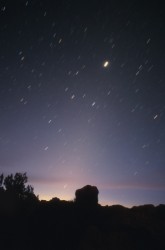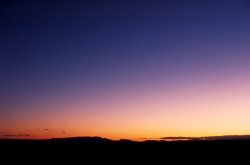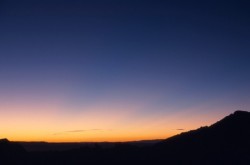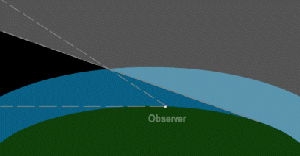|
Introduction
This document describes several optical and celestial phenomena which may occur at, before, during or after twilight.
Many of these can be seen all throughout the year, except for a few. In this text, I will explain the phenomena
in the order they occur during the morning twilight. For evening twilight, the order is ofcourse reversed. Some
phenomena occur predominantly in the morning, while others have a fair chance to be seen in the evening.
Zodiacal light
|

The zodiacal light can sometimes be strikingly bright. It stretches out along the
ecliptic and looks like a tapered column of light.
|
Your enjoyment of the various phenomena possible at the morning twilight starts about 2 to 3 hours before
sunrise. During the fall season, you will have a chance to see the (sometimes stunning) zodiacal light column
rise steeply from the eastern horizon. The zodiacal light is caused by interplanetary dust scattering the
sunlight. The light column is shaped as a slanted pyramid of white light, and can be up to 1 or 2 magnitudes
brigher than the Milky Way, just before twilight.
The reason that the zodiacal light is best seen in the morning during fall is because this is the time that
the ecliptic makes a steep angle with the eastern horizon (because it is just about 3 to 4 months after the
summer solstice). Likewise, the zodiacal light during the evening is best observed
during the spring months. For observers living on the southern hemisphere this would be just the other
way around, but the seasons are also reversed, so for these observers the best observation times given above
are true as well.
Zodiacal light bridge
If you have exceptionally clear skies, you may see that the zodiacal light reaches upward along the ecliptic
as far as past the zenith. Earlier in the night, you may even see that the zodiacal light goes all the way up
along the ecliptic to meet with the gegenschein and the opposite zodiacal light column. This is referred to
as the zodiacal light bridge and is the most difficult of all phenomena to see. You must have your eyes
adapted to the dark for at least 30 minutes and be observing in a truly dark, clear, elevated location, far
(more than 50 km) from major cities.
The zodiacal light near the eastern horizon gets brigher and brighter as time progresses; just before
astronomical twilight it can be very bright and actually cast shadows, as I found out lately. This is why it
is sometimes called the false dawn.
|

All-sky fisheye view of the zodiacal light. On the photo, it stretches over 90o.
Possible Aurora Borealis and the twilight arch are also visible.
|
Astronomical twilight and the development of the twilight arch
When the sun reaches -18o altitude, astronomical twilight starts. This is (for middle latitudes like
30o to 50o) to the order of 90 to 75 minutes before sunrise. You will note that the
eastern horizon starts
to glow faintly, and the zodiacal light merges into a bright white area on the horizon.
20 minutes later or so, you will notice that the developing twilight starts to show colors. It will get a very
pale red at the horizon, and yellow just above it (very hard to detect at first). Not much later, the nautical
twilight starts, when the sun reaches -12o altitude.
Nautical and civil twilight
Nautical twilight is the twilight when the sun reaches -12o altitude and it is still too dark to read,
but noticeably getting lighter. The
Milky way will fade, and the zodiacal light will be visible higher up along the ecliptic. It
is at this time that you can take very nice photographs of the zodiacal light, as it combines well with the
twilight colors. These may not seem so spectacular to the eye, but on a time-exposure on film it will!
|

The twilight arch can display many different hues of colors. Most common is a red-orange-yellow-purple-blue
ordering of colors from the horizon upward. The purple is called the purple red and only occurs for 5 to 10 minutes, during
civil twilight.
|
Color development of the twilight arch
When the sun reaches -6o altitude, roughly 30 minutes before sunrise (again, depending on your latitude,
but true for middle latitudes), civil twilight starts, and it is at this point that things start developing
faster and it gets really interesting. The zodiacal light will fade, to make place for a deep orange twilight
arch stretching almost from N to S. If you are lucky, you will see the inner planets Venus and Mercury,
or perhaps a thin crescent moon.
You may spot a bat flying in front of the arch of light, heading home to have its daytime sleep.
If you are at a remote location with no wind, you may notice that nature is dead silent at this point in time,
and you can hear the blood flow in your ears. Sometimes the silence even gets oppressive!
Purple red
20 minutes before sunrise: note how the twilight arch at the sun's azimuth starts to glow with a purple
hue. This purple color is at first roughly 5o to 10o altitude and stretches about 40o to 60o in azimuth. This
is called the purple red, and is caused by the deeply reddened sun shining from below the horizon onto a high
stratum of aerosols (typically dust, at very high altitudes of up to 16 km). At times of volcanic eruptions,
this purple red may be incredible, and it may look like the eastern horizon is on fire.
|

Twilight crepuscular rays cast on the purple red. These are relatively uncommon. The rays
are usually caused by clouds beyond the horizon, blocking the sunlight from reaching the stratum of aerosols which
are responsible for the purple red. The rays are usually visible as blue beams (shadows) contrasting with the
purple red.
|
Twilight rays
The purple light will quickly expand to a large part of the eastern sky, and if there are clouds or
terrain features below the horizon blocking the sunlight at some places, you may see the uncommon
twilight crepuscular rays - beams of blue and pink light diverging from the horizon, from the point where the
sun is at (which is still below the horizon). Enjoy the show, because this will last only 5 minutes or so,
typically.
Twilight wedge: the Earth's shadow and belt of Venus
Not much later, about 15 minutes before sunrise (solar altitude between -6o and -4o)
the crepuscular
rays (if present), will be seen to span the entire sky, converging again to the antisolar point,
which is to the W and still above the horizon.
So look west, and you will see what is called the twilight wedge, or Earth's shadow band. This band of darker blue
is Earth's shadow being projected onto the dust and haze in Earth's atmosphere. The band will be bordered by
a (sometimes strikingly vivid) pink to brown band - this is sometimes called the belt of Venus, or
countertwilight, and is basically the red twilight arch seen from behind.
The twilight wedge (Earth's shadow) will be seen to lower to the W horizon very quickly. It starts out at
about 20o altitude, and does not represent the solar elevation, because of the geometry of Earth's
shadow compared to you, the observer. As the sun reaches the horizon from below with only a few degrees to
go, you will notice that the shadow band lowers at a much faster rate, and when it is just above the horizon,
will appear sharper. This is because you now look almost edge-on the shadow-boundary, rather than at an
angle. Note how the crepuscular rays may seem to converge right into the belt of Venus.
|
|
| |


Twilight wedge geometry. Earth is green, the atmosphere is blue; sunlit area is drawn in grey, and the sunlight comes
in from the right. In the figure at
the left, the sun is deeper below the horizon, and the observer is seeing a dark band of the atmosphere, bounded
by a very fuzzy boundary with the sunlit atmosphere overhead. However, the thickness of that sunlit part of
the atmosphere is still rather small. In the figure on the right, the tangent point of the sunlight with the Earth
has almost reached the observer, and the observer now has almost exclusively sunlit atmosphere overhead. The observer looks
almost edge-on to the shadow boundary now, so the boundary between sunlit atmosphere and shaded atmosphere
looks very sharp, and has high contrast with the pink Belt of Venus (see upper right photo).
|
|
|

Altocumulus and altostratus can show very spectacular color hues during sunset or sunrise.
|
Cloud coloration
Meanwhile, the twilight arch appears paler yellow and shows less saturated colors. However, if your view was
blocked by altocumulus or stratocumulus clouds, these clouds may be set on fire by the sun at this point.
These clouds can really look stunning at twilight. But enjoy the view or take pictures quickly, because
the colors will not last long.
Sun's green flash
When the twilight wedge reaches the W horizon, the sun will be rising in a matter of minutes. If you are
at a high altitude, or looking out over sea, try to figure out where exactly the sun will be rising (or,
if you have a compass, find out with sky charts beforehand). You will have a fair chance of seeing the
green flash in that
case - but it is hard to detect because you will only see it in the fraction of a second it takes for the
upper sun's limb to appear, and you have to look in the right direction before that happens. Never look
directly at the sun, if it is bright!
Deformation (flattening) of the sun
After these events, most of the interesting and rare phenomena are over. You may, however, see the sun being
distorted or flattened when it is just above the horizon, due to miraging and the temperature gradient of the
atmosphere. If it is winter and freezing, you may see the sun in very strange deformations. But again,
be careful with your vision. Only look at the sun when it is not blinding at first sight, and even then
use caution. Know what you are doing and what the consequences are - I will not be responsible for any eye
damage, as I am warning you now.
|

The sun's green flash is sometimes visible if the sun is near the horizon. The view to the
horizon should be unobstructed, such as over a lake or sea.
|
Sunrise and sunset differences
Note that the same events occur in reverse order at sunset. However, I have found that sunrise usually
brings more saturated twilight colors, possibly because the atmosphere is very clear, cold and quiet then.
Daytime heating causes turbulence and usually cloud development, so you may have a better chance to see
a clear sunrise than a clear sunset (if your weather does not very much depend on synoptic-scale weather
systems like fronts, troughs and so).
Even if the sky is overcast with clouds, it may be worthwhile to go out in the morning to wait for the
sunrise - you will not see most of the phenomena mentioned here, but the cloud colors can be very beautiful.
Preparation
If you are reluctant to go out at 5 AM in the morning or so (or just plain lazy, as most of the people
are), it may help to plan the trip a bit beforehand, so you will know what to look for and what to see.
Otherwise, it may be boring to stand in the chilly weather and wait for hours for something to happen. It
certainly helps to know what phenomena are possible and how rare they are, so you get some sense of interest
before watching. Otherwise, something that is extremely rare may not really impress, and this would be a
shame.
If you happen to see all the phenomena described here, you will actually be busy taking pictures and/or
enjoying, for three consecutive hours! And I didn't even mention Iridium flares, solar light pillars, fog,
ice and so on... you may see a lot out there, and every time you will see something different. Enjoy nature,
as it is the best movie cinema, all for free. If people were not so used to twilight,
everybody would run outdoors in awe. Most people don't, but that doesn't make it any less beautiful!
|